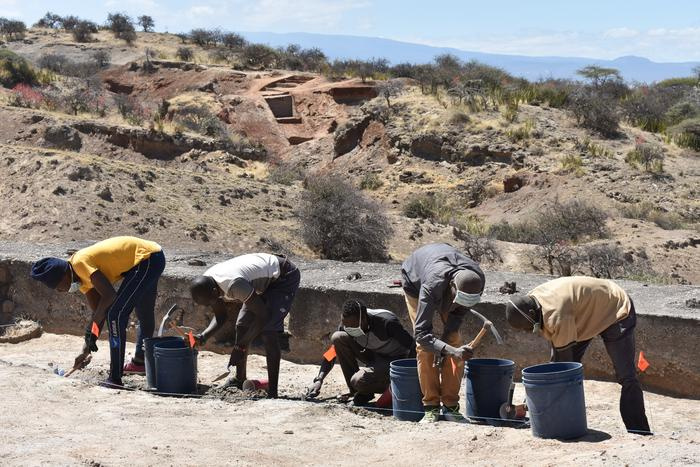More than 1.2 million years ago, our ancestors Homo erectus developed the tools and intellectual capacity to survive in very dry conditions, new findings indicate. The adaptation was important to human survival, breaking us out of our dependence on a relatively scarce ecosystem. It may also have been crucial to our first great expansion into Eurasia, but raises some questions about what came after.
Humans are distinguished from our ape cousins by the range of environments in which we can live. Even before we invented air conditioning and water purification plants, we managed to survive everywhere from hot deserts to the Arctic and Tibetan Plateau.
Working out when and how we learned to do this is a big question in human evolution, and some researchers propose the answer has been under our noses at one of the most heavily studied palaeoanthropological sites: Olduvai (or Oldupai) Gorge.
The gorge is famous for the long record of stone tools found there, dating back to more than 3 million years, and even older bones of pre-Homo species. However, one team claims that between 1.2 million and 1 million years ago, the desert came to us, and climate conditions dried the area out. Earlier humans would have had to move to wetter country, the authors believe, which might have been in short supply at the time.
H. erectus, however, maintained its presence, based on evidence found at the Engaji Nanyori site within the gorge. Tools continue to be found at the site over this time, intermingled with proxies of the climate.
Other animals might evolve camel-like capacities to go for long periods without water under such conditions, but H. erectus’ advantage lay in its brain.
“Now extinct, Homo erectus existed more than an estimated 1.5 million years, marking them as a species survival success in the human evolution story when compared with our own estimated existence of around 300,000 years to date,” said study author Professor Michael Petraglia of Griffith University in a statement.
According to the authors, the toolmakers developed a sophisticated understanding of where water persisted through dry periods, and returned there repeatedly. That may not be so different from the memory of elephants, or many animals’ capacity to detect water from far off. However, the authors also say advancements in tool use also contributed.
“Traditionally, only Homo sapiens was thought capable of sustained occupation in such ecosystems, with archaic hominins seen as restricted to narrower ranges,” explained study author Dr Abel Shikoni of the University of Dodoma. However, Shikoni and colleagues argue that the perception that H. erectus had a restricted ecological range is based on fragmentary data from a limited number of sites. Our knowledge of the conditions at these sites when they were occupied is often lacking.
To address this, the team reconstructed the conditions at Engaji Nanyori during the Middle Pleistocene Transition between 1.2 to 0.8 million years ago. They conclude that for the first 200,000 years, vegetation in the area matched what is found in modern-day semideserts, in contrast to previous studies that reported more favorable conditions at the time. For example, Ephedra now grows only on the margins of the Sahara far to the north of the gorge, but its presence has been identified during this period. Water levels in lakes and rivers in the area, fire frequency, and reconstructions of regional climate from proxies elsewhere support this conclusion.
Nevertheless, tools continued to be left at the site and buried in sediments that date them to this period.

Excavations at Engaji Nanyori, Oldupai Gorge, Tanzania looking for ancient tools, and climate proxies from the same times.
Image credit: Julio Mercader
If H. erectus could survive at Engaji Nanyori, they must have had capacities we have not previously recognized, most likely in the creation of more sophisticated tools. At the time, Engaji Nanyori featured a higher proportion of retouched tools, such as scrapers and “denticulates” (stones notched to make a serrated edge), which the authors argue optimized the processing of prey in a dryland niche.
Although the findings go against previous perceptions of H. erectus, they do explain how it became the first hominin to not only cross the deserts of the Middle East, but reach places as distant as islands in Southeast Asia. It had been thought such an expansion must have occurred during narrow windows when deserts turned to grasslands, perhaps leaving pockets of H. erectus cut off from each other when conditions changed and deserts formed in between. Recasting H. erectus as a more adaptable species makes this migration easier to understand.
On the other hand, our own species is thought to have evolved around 250,000 to 300,000 years ago. Despite occasionally venturing beyond Africa, we do not appear to have been able to sustain that presence until 60,000 to 100,000 years ago. If early H. sapiens had all the technology inherited from H. erectus, and some more as well, along with larger brains, why were these deserts such a barrier?
The study is published in Communications Earth & Environment.
Source Link: Early Humans Adapted To Extreme Deserts More Than A Million Years Ago